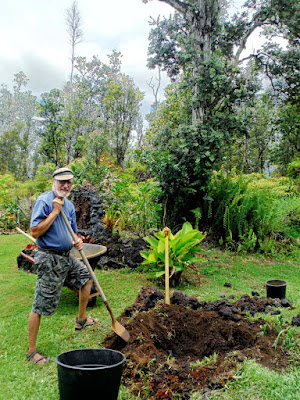
We have been doing a bit of research about what kinds of
trees we want to replace our lovely Ohia trees as they die.
Right now, our property is surrounded by a
stately Ohias, but so far, the only ones dying are up nearer to the front of
the property.
If you have a mental image
for Hawaii of
white sand beaches and palm
trees then that’s not where we live.
We live in a tropical forest with many kinds of beautiful trees.
Whatever we choose to plant needs to appear natural in this
forested setting. As we began our tree
search, however, we were finding an abundance of palm trees (hundreds of kinds),
fruit trees by the dozens, and lots of
exotic imports. Although there are LOTS
of beautiful palms available, and we have a few, that was not the direction we
wanted to go. Given the infected, dying ohias,
using them as replacements just didn’t seem wise either. Because of our age, we don't have 20 years to wait -- we want to enjoy our forest soon!
Many phone conversations and emails later, most of which
simply referred me to other leads that just didn’t pan out, we got a hit and it led me to a charming dedicated tree and forest LOVER -- Jill, of Future Forest Nursery right here on
the Big Island. Jill is a silviculturalist whose passion of 24 years has been
“silviculture” – controlling (growing, planting and monitoring) the
establishment and quality of forests – for a variety of uses/reasons.
She listened as I explained my desire for a “real forest”
sidestepping the easy palm solution.
Despite the fact that her chosen profession regularly deals with
thousands of trees and large forest-related projects, she listened as I gave
her my “Tree Wish List” of 1) Native and endemic Hawaii trees, 2) hardwood
trees 3) eucalyptus, 4)flowering/ornamentals.
Her reply was “I have all those!”
So I made arrangements with her to come and pick them up at her
magical wonderland property up in the hillsides above Kailua-Kona.
We are very excited about our new baby trees, which
Jill assured us we would be fully enjoying within five years. So, here are a few photos of the 13 different
varieties that will be part of Luana Ohana Forest.
I asked Jill if it was OK to share her contact info with you and she said yes; however, she also said to remind people that sometimes it takes months for new seedlings, so she is always rotating a variety of trees. Her website is extensive and well worth a visit: www.forestnursery.com. MAHALO JILL!

 Yesterday's headlines read "Ohia in Trouble" and shared a similar story to those we included in previous blog entries. One additional quote stood out, however. A research ecologist with the US Forest Service graphically outlined the severity of this crisis with the following quote.
Yesterday's headlines read "Ohia in Trouble" and shared a similar story to those we included in previous blog entries. One additional quote stood out, however. A research ecologist with the US Forest Service graphically outlined the severity of this crisis with the following quote.










